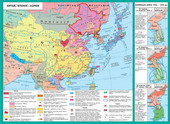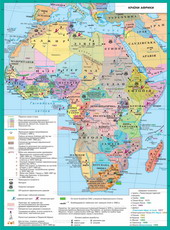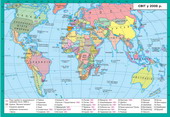§ 32. India
1. The gaining of independence by India
In the British Empire, Indiawas a coherent territory, which ruled viceroy. Population it wasmulti-ethnic and also of different religions. The largest religiousgroups were Hindus and Muslims. There was and administrative unity.Hindustan Peninsula was divided into provinces, counties, principalities. All thisdisrupted the cohesion of the population.
Leaders of the two main communities - HinduNational Congress and Muslim League together initially opposedcolonial dependence, so India has received dominion status.
Meanwhile it became clear thatMuslim League seeks not only independence but also the formation of a separate Muslimstate in which Muslims would have more reliable guarantee of development. In thisThey found support from the metropolis.
Between the two religious groups and theirleaders were not understanding. When the Muslim League agreed to takeparticipation in the provisional government, an idea put forward by the British, then it is goneNational Congress. Conversely, when the initiative of the National Congressmen of the Constituent Assembly, the Muslim League boycotted the elections to them.Between Hindus and Muslims occasionally clashes broke out, stop that,According to politicians in England and in India itself, could only geographicallyroz'yednavshy warring parties.
In August 1947 India wasdivided into two states - Indian Union and Pakistan. Indian Unioncovered most of the peninsula. Pakistan went to the province to the west andeast of India, who thus found themselves geographically disconnected.
The establishment of two states is not stoppedHindustan tragedy. Started population exchange between the two countries. Migrationaccompanied by mass killings like the one or the other. Inmutual slaughter killed about 100 thousand people. Only a tough stanceMahatma Gandhi, who declared a hunger strike until until it stopsslaughter, and killing one of his Hindu fanatics stopped sheddingblood.
2. Development of the Republic of India in 50 to 80 years of the twentieth century.
The first steps of its existenceThe Republic of India began with agrarian reform. In that landlords have been removedpart of their land which they leased (about 60% of holdings). Thisland was transferred to the same tenant. With new facilities for giving landstate taxes and received from these funds was calculated with the landlords. Incountry emerged a new class of small peasant landowners.
Jawaharlal Nehru, who ledgovernment was heavily influenced by social ideas. He sought expansionpublic sector in industry, planned economic development. Statesector created in areas which required huge investments, whichwere not able to do some private owners (in black and colormetallurgy, engineering, oil refining, chemical industry,energy). At the same time not chynylosya barriers to the development of private enterprise.
The hard rozv'yazuvalosyanational question. The area is inhabited by many nations of India, which are differentculture, language, religion. After the country gained independence, they begancreation of administrative units. In 1956, appeared 14 new states and6 territories controlled by the center. However, after continued fightingcertain ethnic groups for that to have your own staff.
In addition,India has not reached general agreement on the state language. SuchHindi language is offered. Against were some states who saw in this discriminationother nations. When the proposals were heard to leave the English language, withdo not accept this national-patriotic forces. Deepened the contradiction betweenseparate castes. Higher castes were fighting among themselves for power. Lower castesdemanded more rights for themselves.
Scheme: Features of India
Course Nehru called opposition fromthe forces that defended the free market, private property and unscheduledeconomy, and opposed the policy of neutrality and alliance with the West.Nehru regarded with particular sympathy for the Soviet Union. The situation Nehrucomplicated in 1962 when China claims expressed in some Indianterritory and took them. Opposition parties accused the Nehru that he did notable to give strong rebuff the aggressor through ideological affinity with him. Simultaneouslywas split in the Indian National Congress. One part is requiredgreater implementation methods in socialist economy. Another contrast,Nehru criticized by socialist experiments. The crisis in the party existed. Inmidst of discussions May 27, 1964 Nehru died.
After his death in the mid 60'syears in the country began a long economic crisis. Identified failurekeep the budget such a large public sector, as itNehru planned. Of the agrarian reform increased labor productivitynew owners. Instead, the lands remaining in the landlords and rich peasants,it grew.
Read a radical agrarian reform inelimination of traditional communal (public) government did not want life. This wouldled to uncontrolled growth of cheap labor in the cities that would notable to absorb newcomers. Flashed to social tensions that coulderupt in an uncontrolled mob action. There would have fallen standard of living.Exacerbated political and national issues.
The crisis forced the Indian Congressreconsider its policy. More attention was paid to private sectorindustry. Instead of the annual five-year plan developed. In agriculturesector resources are allocated selectively - the most advancedpredominantly agricultural region and strong businesses.
I wonder
Prime Minister of India
|
Prime ministers
|
Years tenure
|
Party accessory
|
|
J. Nehru
|
1947-1964
|
Indian National Congress (INC.)
|
|
LB Shastri
|
1964-1966
|
INC.
|
|
Indira Gandhi
|
1966-1977
|
INC.
|
|
M. Dessau
|
1977-1979
|
Janata Party (People's Party)
|
|
Singular Singh
|
1979-1980
|
Lok-dal
|
|
Indira Gandhi
|
1980-1984
|
INC. (Indira)
|
|
Rajiv Gandhi
|
1984-1989
|
INC. (I)
|
|
VP Singh
|
1989-1991
|
National Front
|
|
N. Rao
|
1991-1996
|
INC. (I)
|
|
AB Vajpayee
|
1996
|
Bharatiya Janata Party
|
|
H.D.Deva-Govda
|
1996-1997
|
Unions Front
|
|
IK Hudzhral
|
1997-1998
|
Unions Front
|
|
AB Vajpayee
|
1998-
|
Bharatiya Janata Party
|
The new Prime Minister was LalBahadur Shastri. Among the acute problems with which he immediately encountered wasnational. In every state of resident representatives of several nationalities.The most numerous used their superiority to their advantage. Nationalminority did not want to put up with discrimination. Began fighting at the nationalsoil. Failed to resolve a single official language. Englishremained second, but Hindi, the official language in the republic. In those states wherenot speak Hindi, the third official language is declared and the local.Continued confrontation between Hindus and Muslims, especially in Jammu andKashmir. In 1961, 1963, 1964 and 1967 it resulted in clashes with the pogromsand murders.
In addition, Kashmir was the causeconflict between India and Pakistan. Once formed, these two states, onethird of Kashmir went to Pakistan, the rest - to India. Bothclaimed to possess the whole territory. In 1965, on this groundconflict broke out, which nearly turned into a real war. It helped interferenceUSSR, which would not have a military fire near their borders. Onnegotiations in Tashkent in early January 1966 was agreedcessation of hostilities. Soon after Shastri died suddenly.
Indo - Pakistan War
|
Years
|
Name
|
Causes
|
Result
|
|
1947-1948
|
|
Fighting for strategic importance of Kashmir principality
|
January 1 1949 India and Pakistan signed a ceasefire agreement and establish demarcation line in Jammu and Kashmir.
|
|
1965-1966
|
Second Kashmir War
|
Absence demarcation of borders in the desert areas. Restoration of the struggle for Kashmir
|
Withdrawal troops to previous positions.
Of demarcation (except Kashmir). Signing of the Declaration on the Non- forces and the resumption of negotiations.
|
|
1971
|
Fighting for independence of East Pakistan
|
Crisis in between East and West Pakistan. Support for India benhaltsiv
|
Proclamation independence of East Pakistan - People's Republic of Bangladesh
|
|
End 90 years.
|
Aggravation border conflict in Kashmir
|
Revitalization Muslim separatists in Kashmir. Clashes on border
|
Aggravation situation. Opposition to nuclear escalation
|
After his death in a split INC.increased. At the next general election in 1967 each part of the party nominatedtheir candidate. Those who continued to rate Nehru supported his candidacydaughter Indira Gandhi.
In the elections INC., albeit with largedifficulties, but won most seats in parliament. However, compared withprevious elections he handed over the position. Increased weight of other parties. Indiaceased to be a country with one-party rule. Indira Gandhi stronglyconducted the course of his father. Summer 1969 it nationalized in 1914largest private banks, at the end of that year approved a law under which monopolycould be made only with government approval. It also increased allocations forpublic sector industries. It was nationalized cotton imports.
In foreign policy, Indira Gandhiextended line of Nehru - neutrality and joining the military and politicalblocks, supporting national liberation movements, strengthening relations with the SovietUnion.
Scheme: Foreign Policy of Indiaproduced by J. Nehru
|
Equality and mutual benefits
|
Peace coexistence
|
Mutual respect for territorial integrity and sovereignty
|
Mutual non-aggression
|
Mutual non-interference in internal affairs
|
With this party politics INC.won early parliamentary elections in 1971
Introducing the socialistprinciples in the economy even though Congress and helped popularize among poorerpopulation, but in general led to a worsening economic situation in the countrybecause of low efficiency of the public sector. In addition, zahalmuvalysyaland reform, more effective use of agricultural technologies.The country suffered from food shortage.
In 1974 opposition beganmassive anti-government campaign. Extremist elements from the opposition committed attemptsto government officials. Indira Gandhi persuaded President Ahmad enter from June 261975 in a state of emergency. The constitution was suspended,banned opposition organizations, and 30 thousand of their activists were arrested.
In 1975 was highest in the countrycorn crop and food prices are not increased. Distribution of recovered landpeasants. , Indira Gandhi decided to exploit the situation and in 1977announced parliamentary elections. However, population vybachylo her extraordinarystate and voted for tumors Janata Party (People's Party), whichCongress included opposition groups.
As Janata desk wereOrganization of the opposite platform, in 1979 it split andnext year's Indira Gandhi again became prime minister.
In 1984, there was a crisis in the statePunjab, where a large Sikh community of Muslims. They have longPunjab sought accession to Pakistan. Home Sikh shrine -Golden Temple in Amritsar - turned into an armed arsenal and headquartersseparatists. Indira Gandhi had ordered the temple to capture and arrest the rebels.In response group sikhskyh extremists October 31, 1984 committed to itattempt, due to which Indira Gandhi was killed.
After the death of Indira GandhiPrime Minister was her son Rajiv Gandhi, who took the time commitmentmost members INC.. The new government also faced the problem of national andreligious extremism. In 1987 Rajiv Gandhi sent troops to the neighboringSri Lanka, where Tamil people extremist organization - TigersLiberation of Tamil Eelam "- led the fight against the central government, trying to dividecountry. Indian troops helped quell the separatists, which led toRajiv Gandhi's hatred of the Tamil people living in India. In 1988 againcrisis erupted in Punjab. Like his mother, Rajiv Gandhi gave orders to seizeGolden Temple, where Sikh separatists raid.
Rajiv Gandhi had to doActing Prime Minister, became more obvious when failuresocialist experiment. In addition, and he gave her a way of lifereasons for discontent: rarely contacted with the population, significantly increasedbodyguard, too much attention paid his own comfort. AgainstEconomic hardship is irritated Indians.
To give new impetus to the economyR. Gandhi started the reforms with the liberalization of economic life, which continuedhis successors.
The growth rate of GDP in India1950-2002 biennium
|
Years
|
Percentage per year
|
|
1950-1980 biennium
|
The average period of 3,5%
|
|
1980-1990 biennium
|
The average period of 5,4%
|
|
1990-2002 biennium
|
The average period of 5,9%
|
3. India in 90 years of the twentieth century. - EarlyXXI century.
Unpopularity premiere especiallydemonstrated during the 1989 election INC. has failed to win an absolutemajority of seats. The Government formed the National Front, in whichunited opposition Congress party. Prime Minister became party leaderJanata Pratar Singh.
In 1990, He has made a decisionwhereby 27% of jobs in the public sector representatives themselves"Lower" castes and tribes. Decision Singh caused a government crisis,because it zazihnuv one of the most sacred traditions of India - castesystem. Representatives of the "higher" castes find it shameful eventhat "lower" castes are given equal rights with them. Undercaste system pressure defenders Singh was forced to resign. PositionPrime Minister belonged to socialist Chandra Shekhara.
In 1991, startedelection campaign. The best chances were in the Indian nationalCongress. Rajiv Gandhi had every reason to count on as prime minister, butMay of that year was killed by Tamil extremists during a meeting withvoters. New leader Narasimha Rao became INC.. After the victory of the Congress hehe became prime minister.
Narasimha Rao immediately headedmore realistic and pragmatic policy. His economy rate predictedprivatization of public sector, corporatization of enterprisesPublic sector to increase revenue. The main purposeGovernment was moving away from command-administrative methods thatproved ineffective. The development of competitive, integrated into the globaleconomy.
Stages of Economic Development of India
|
Periods
|
Modernization strategy
|
|
1940-1950-E years
|
Transition possession of the colonial state authorities. Formation of the public sector. Planned development of the public sector. Deprivation of rights of landlords to collect taxes on rural communities. Giving tenants the right of redemption of land
|
|
1960-1970-E years
|
Nationalization large banks of larger wholesalers. The size of land possessions. Strengthening public sector (20% industry). Of "Green revolution" - the transition to self-sustaining agricultural products.
|
|
1980-1990-E years
|
Partial liberalization of foreign trade. Attracting foreign investment in the new field production. Support for private enterprise.
|
|
Beginning XXI century.
|
Privatization public sector. Promotion of private business.
|
INC. seeks a unifiedIndian nation with equal rights and opportunities for all tribes and peoples. Themresist extreme "patriots" who sought the provision of Hinduscentral place in society. The major part of this spectrum is the BharatiyaJanata Party (BJP) They rely on the support of the poorest and leasteducated part of the population that India has hundreds of millions of people. OnElection 1996 BJP, in the wake of allegations of corruption and personally INC.Narasimha Rao wins. However, to form a stable government it could not.Coalition has become a leading feature of political life in India. In earlyElection 1998 BJP wins again. The Prime Minister wasAB Vajpayee. In domestic policy, his Government continued its policy of their predecessors. In1999 launched mass privatization of the public sector. In foreigngot tough especially in relations with Pakistan. The arms race withPakistan became a nuclear and missile potential turnedIndo-Pakistani conflict in the most dangerous on the planet. Ordinaryexacerbation entered Kashmir problem, which for years claimed the lives of existence in 1940ths. In 1999 BJP wins in special elections. In2000-2001, broke new political crisis, connected with corruption inhigher power. Now she has been engaging the leaders of BJP.
Despite the complex problemsCurrently in India continued steady economic growth, couldTranslate Indo-Pakistani conflict in the negotiation plane.
Problems of modern India
|
·
Unsolved problems borders with Pakistan and China.
|
|
·
Nuclear confrontation with Pakistan.
|
|
·
Surging population.
|
|
·
Domination patriarchal relations in the countryside.
|
|
·
Separatist movements (Jammu and Kashmir, West Bengal, Tamil Nadu, Punjab).
|
|
·
Software stable economic growth.
|
Results
India has implemented a distinctive model of modernization,which proved very effective. In terms of socio-political development,India has unique characteristics. Back in colonial times were establishedfoundations of local government. Lay the foundations of federalism, the partyINC. has an extensive system in the country. This allowed India sinceindependence to establish itself as a democratic state. Long timeIndian democracy has its own characteristics: dominance in political life and INC.Gandhi family.
The economy of India succeededavoid large-scale experiments, connected with the radical breakingtraditional foundations. India retained its normal course of life, but this did not stop herprogress towards progress.
Developing country has its problems:relations with Pakistan, which escalated into nuclear confrontation, the rapid growthpopulation, which entails a number of socio-economic problems;separatist and extremist movements.

"Pearl" India's mausoleumTaj Mahal
Questions and tasks:
1. Why British India was divided into two states? By what principle wasby this division?
2. Why the distribution territory of British India led to bloodshed?
3. Identify the stages of economic development of India and give them a description.
4. What course of Nehru? What are the consequences of its implementation for development?
5. How can I explain the battery power in the country of Gandhi family andINC.?
6. How has the Indo-Pakistani conflict? On what basis canreconciliation between the two neighbors?
7. The population of India is less than the Chinese population of about 250 million people. Why the number ofpopulation inhibits economic development of China and India - inhibits?
8. Identify the main problems of India at the present stage and let themcharacteristic.
 English
English




















